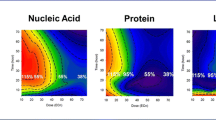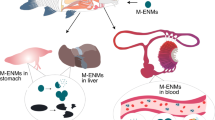Abstract
Nanotoxicology, a new branch of bionanoscience, deals with the study and application of the toxic or biological effects of nanomaterials or nanostructures, and aims to fill gaps in our knowledge of interactions between nano- and biosystems. However, progress in this new discipline largely relies on developing methodology to characterize nanomaterials in biological samples, quantify nanoparticles in living systems, and study their uptake, translocation, biodistribution, location and chemical status in vitro and in vivo, etc. In this review article, we focus on the main features of synchrotron radiation-based methods and their application to the study of the toxicological activities of nanomaterials. Synchrotron radiation-based analytical techniques are shown to provide a potent means for characterizing the toxic or biological behaviors of nanoparticles in biological systems.









Similar content being viewed by others
References
Nowack B, Bucheli TD (2007) Occurrence, behavior and effects of nanoparticles in the environment. Environ Pollut 150:5–22
Marquis BJ, Love SA, Braun KL, Haynes CL (2009) Analytical methods to assess nanoparticle toxicity. Analyst 134:425–439
Asharani PV, Wu YL, Gong ZY, Valiyaveettil S (2008) Toxicity of silver nanoparticles in zebrafish models. Nanotechnology 19:255102–255109
Porter AE, Gass M, Muller K, Skepper JN, Midgley PA, Welland M (2007) Direct imaging of single-walled carbon nanotubes in cells. Nat Nanotechnol 2:713–717
Russo RE, Mao XL, Liu HC, Gonzalez J, Mao SS (2002) Laser ablation in analytical chemistry—a review. Talanta 57:425–451
Ortega R, Devès G, Carmona A (2009) Bio-metals imaging and speciation in cells using proton and synchrotron radiation X-ray microspectroscopy. J R Soc Interface 6:S649–S658
Tsuji K, Nakano K, Hayashi H, Hayashi K, Ro CU (2008) X-ray spectrometry. Anal Chem 80:4421–4454
Bertsch PM, Hunter DB (2001) Applications of synchrotron-based X-ray microprobes. Chem Rev 101:1809–1842
Gekko K, Yonehara R, Sakurada Y, Matsuo K (2005) Structure analyses of biomolecules using a synchrotron radiation circular dichroism spectrophotometer. J Electron Spectrosc Relat Phenom 144–147:295–297
Potts PJ, Ellis AT, Holmes M, Kregsamer P, Streli C, West M, Wobrauschek P (2000) X-ray fluorescence spectrometry. J Anal At Spectrom 15:1417–1442
Tsiji K, Injuk J, Grieken RV (2004) X-ray spectrometry: recent technological advances. Wiley, Chichester
Rao CNR, Biswas K (2009) Characterization of nanomaterials by physical methods. Annu Rev Anal Chem 2:425–462
Wang JX, Zhou GQ, Chen CY, Yu HW, Wang TC, Ma YM, Jia G, Gao YX, Li B, Sun J, Li YF, Jiao F, Zhao YL, Chai ZF (2007) Acute toxicity and biodistribution of different sized titanium dioxide particles in mice after oral administration. Toxicol Lett 168:176–185
Matsuyama S, Mimura H, Yumoto H, Sano Y, Yamamura K, Yabashi M, Nishino Y, Tamasaku K, Ishikawa T, Yamauchi K (2006) Development of scanning x-ray fluorescence microscope with spatial resolution of 30 nm using Kirkpatrick–Baez mirror optics. Rev Sci Instrum 77:103102–103106
Schroer CG, Kuhlmann M, Hunger UT, Gunzler TF, Kurapova O, Feste S, Frehse F, Lengeler B, Drakopoulos M, Somogyi A, Simionovici AS, Snigirev A, Snigireva I, Schug C, Schroder WH (2003) Nanofocusing parabolic refractive X-ray lenses. Appl Phys Lett 82:1485–1487
Rau C, Crecea V, Liu W, Richter CP, Peterson KM, Jemian PR, Neuhäusler U, Schneider G, Yu X, Braun PV, Chiang TC, Robinson IK (2007) Synchrotron-based imaging and tomography with hard X-rays. Nucl Instrum Meth B 261:850–854
Wang B, Feng WY, Wang M, Shi JW, Zhang F, Ouyang H, Zhao YL, Chai ZF, Huang YY, Xie YN, Wang HF, Wang J (2007) Transportation of intranasal instillation of fine Fe2O3 particles in brain: micro-distribution, chemical states, and histopathological observation. Biol Trace Elem Res 118:233–243
Wang JX, Chen CY, Yu HW, Sun J, Li B, Li YF, Gao YX, Chai ZF, He W, Huang YY, Zhao YL (2007) Distribution of TiO2 particles in the olfactory bulb of mice after nasal inhalation using microbeam SRXRF mapping techniques. J Radioanal Nucl Chem 272:527–531
Gao YX, Liu NQ, Chen CY, Luo YF, Li YF, Zhang ZY, Zhao YL, Zhao BL, Iida A, Chai ZF (2008) Mapping technique for biodistribution of elements in a model organism, Caenorhabditis elegans, after exposure to copper nanoparticles with microbeam synchrotron radiation X-ray fluorescence. J Anal At Spectrom 23:1121–1124
Jackson BP, Pace HE (2009) Synchrotron X-ray 2D and 3D elemental imaging of CdSe/ZnS quantum dot nanoparticles in Daphnia magna. Anal Bioanal Chem 394:911–917
Kemner KM, Kelly SD, Lai B, Maser J, O’Loughlin EJ, Sholto-Douglas D, Cai Z, Schneegurt MA, Kulpa CF, Nealson KH Jr (2004) Elemental and redox analysis of single bacterial cells by X-ray microbeam analysis. Science 306:686–687
Yang LC, McRae R, Henary MM, Patel R, Lai B, Vogt S, Fahrni CJ (2005) Imaging of the intracellular topography of copper with a fluorescent sensor and by synchrotron X-ray fluorescence microscopy. Proc Natl Acad Sci 102:11179–11184
Chen KG, Valencia JC, Lai B, Zhang GF, Paterson JK, Rouzaud F, Berens W, Wincovitch SM, Garfield SH, Leapman RD, Hearing VJ, Gottesman MM (2006) Melanosomal sequestration of cytotoxic drugs contributes to the intractability of malignant melanomas. Proc Natl Acad Sci USA 103:9903–9907
Finney L, Mandava S, Ursos L, Zhang W, Rodi D, Vogt S, Legnini D, Maser J, Ikpatt F, Olopade OI, Glesne D (2007) X-ray fluorescence microscopy reveals largescale relocalization and extracellular translocation of cellular copper during angiogenesis. Proc Natl Acad Sci USA 104:2247–2252
Paunesku T, Vogt S, Lai B, Maser J, Stojicevic N, Thurn KT, Osipo C, Legnini D, Wang Z, Lee C, Woloshak G (2007) Intracellular distribution of TiO2–DNA oligonucleotide nanoconjugates directed to nucleus and mitochondria indicates sequence specificity. Nano Lett 7:596–601
Chen Z, Chen H, Meng H, Xing GM, Gao XY, Sun BY, Shi XL, Yuan H, Zhang CC, Liu R, Zhao F, Zhao YL, Fang XH (2008) Bio-distribution and metabolic paths of silica coated CdSeS quantum dots. Toxicol Appl Pharm 230:364–371
Petibois C, Guidi MC (2008) Bioimaging of cells and tissues using accelerator-based sources. Anal Bioanal Chem 391:1599–1608
Xia T, Kovochich M, Liong M, Mädler L, Gilbert B, Shi HB, Yeh JI, Zink JI, Nel AE (2008) Comparison of the mechanism of toxicity of zinc oxide and cerium oxide nanoparticles based on dissolution and oxidative stress properties. ACS Nano 2:2121–2134
Zhu MT, Feng WY, Wang B, Wang TC, Gu YQ, Wang M, Wang Y, Ouyang H, Zhao YL, Chai ZF (2008) Comparative study of pulmonary responses to nano- and submicron-sized ferric oxide in rats. Toxicology 247:102–111
Auffan M, Achouak W, Rose J, Roncato MA, Chanéac C, Waite DT, Masion A, Woicik JC, Wiesner MR, Bottero JY (2008) Relation between the redox state of iron-based nanoparticles and their cytotoxicity toward Escherichia coli. Environ Sci Technol 42:6730–6735
Auffan M, Rose J, Orsiere T, De Meo M, Thill A, Zeyons O, Proux O, Masion A, Chaurand P, Spalla O, Botta A, Wiesner MR, Bottero JY (2009) CeO2 nanoparticles induce DNA damage towards human dermal fibroblasts in vitro. Nanotoxicology 3:161–171
Sun HW, Zhang XZ, Niu Q, Chen YS, Crittenden JC (2007) Enhanced accumulation of arsenate in carp in the presence of titanium dioxide nanoparticles. Water Air Soil Pollut 178:245–254
Zhang XZ, Sun HW, Zhang ZY, Niu Q, Chen YS, Crittenden JC (2007) Enhanced bioaccumulation of cadmium in carp in the presence of titanium dioxide nanoparticles. Chemosphere 67:160–166
Scheckel KG, Luxton TP, El Badawy AM, Impellitteri CA, Tolaymat TM (2010) Synchrotron speciation of silver and zinc oxide nanoparticles aged in a Kaolin suspension. Environ Sci Technol 44:1307–1312
Duan YM, Liu HT, Zhao JF, Liu C, Li ZR, Yan JY, Ma LL, Liu J, Xie YN, Ruan J, Hong FH (2009) The effects of nano-anatase TiO2 on the activation of lactate dehydrogenase from rat heart. Biol Trace Elem Res 130:162–171
Zhong J, Song L, Meng J, Gao B, Chu WS, Xu HY, Luo Y, Guo JH, Marcelli A, Xie SS, Wu ZY (2009) Bio–nano interaction of proteins adsorbed on single-walled carbon nanotubes. Carbon 209:967–973
Li N, Ma LL, Wang J, Zheng L, Liu J, Duan YM, Liu HT, Zhao XY, Wang SS, Wang H, Hong FS, Xie YN (2010) Interaction between nano-anatase TiO2 and liver DNA from mice in vivo. Nanoscale Res Lett 5:108–115
Wallace BA, Janes RW (2003) Circular dichroism and synchrotron radiation circular dichroism spectroscopy: tools for drug discovery. Biochem Soc Trans 31:631–633
Kelly SM, Jess TJ, Price NC (2005) How to study proteins by circular dichroism. Biochim Biophys Acta 1751:119–139
Acknowledgements
The authors are grateful to the Foundations of the MOST 973 program (2006CB705605, 2009CB930204), the CAS Knowledge Innovation Program (KJCX3.SYW.N3), and the National Natural Science Foundation of China (10975148, 10905064 and 20805048), and 973 program 2010CB933904.
Author information
Authors and Affiliations
Corresponding authors
Rights and permissions
About this article
Cite this article
Wang, B., Wang, Z., Feng, W. et al. New methods for nanotoxicology: synchrotron radiation-based techniques. Anal Bioanal Chem 398, 667–676 (2010). https://doi.org/10.1007/s00216-010-3752-2
Received:
Revised:
Accepted:
Published:
Issue Date:
DOI: https://doi.org/10.1007/s00216-010-3752-2




